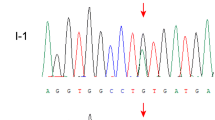Abstract
The kyphoscoliotic type of the Ehlers-Danlos syndrome (EDS VIA) is a rare recessively inherited connective tissue disorder characterized by bruisable, hyperextensible skin, generalized joint laxity, severe muscular hypotonia at birth and progressive congenital scoliosis or kyphosis. Deficiency of the enzyme lysyl hydroxylase 1 (LH1) due to mutations in PLOD1 results in underhydroxylation of collagen lysyl residues and, hence, in the abnormal formation of collagen cross-links. Here, we report on the clinical, biochemical, and molecular findings in six Egyptian patients from four unrelated families severely affected with EDS VIA. In addition to the frequently reported p.Glu326_Lys585dup, we identified two novel sequence variants p.Gln208* and p.Tyr675*, which lead either to loss of function of LH1 or to its deficiency. All affected children presented with similar clinical features of the disorder, and in addition, several dysmorphic craniofacial features, not yet described in EDS VIA. These were specific for the affected individuals of each family, but absent in their parents and their unaffected siblings.
Conclusion: Our description of six patients presenting with a homogeneous clinical phenotype and dysmorphic craniofacial features will help pediatricians in the diagnosis of this rare disorder.



Similar content being viewed by others
Abbreviations
- CT:
-
Computer tomography
- EDS:
-
Ehlers-Danlos Syndrome
- EDSVIA:
-
Kyphoscoliotic type of the Ehlers-Danlos Syndrome
- EMG:
-
Electromyography
- HP:
-
Hydroxylysyl-pyridinoline
- LH1:
-
Lysyl hydroxylase 1
- LP:
-
Lysyl-pyridinoline
- NCV:
-
Nerve conduction velocity
- PLOD1 :
-
Gene coding for procollagen-lysine, 2-oxoglutarate 5-dioxygenase 1
References
Beighton P (1970) Serious ophthalmological complications in the Ehlers-Danlos syndrome. Br J Ophthalmol 54:263–268
Beighton P, De Paepe A, Steinmann B, Tsipouras P, Wenstrup RJ (1998) Ehlers-Danlos syndromes: revised nosology, Villefranche, 1997. Am J Med Genet 77:31–37
Bodanowitz S, Hesse L, Pöstgens H, Kroll P (1997) Retinal detachment in Ehlers-Danlos syndrome. Treatment by pars plana vitrectomy. Ophthalmologe 94:634–637
De Paepe A, Malfait F (2012) The Ehlers-Danlos syndrome, a disorder with many faces. Clin Genet 82:1–11
Giunta C, Randolph A, Al-Gazali LI, Brunner HG, Kraenzlin ME, Steinmann B (2005) Nevo syndrome is allelic to the kyphoscoliotic type of the Ehlers-Danlos syndrome (EDS VIA). Am J Med Genet 143A:158–164
Giunta C, Randolph A, Steinmann B (2005) Mutation analysis of the PLOD1 gene: an efficient multistep approach to the molecular diagnosis of the kyphoscoliotic type of Ehlers-Danlos syndrome (EDS VIA). Mol Genet Metab 86:269–276
Hautala T, Heikkinen J, Kivirikko KI, Myllyla R (1993) A large duplication in the gene for lysyl hydroxylase accounts for the type VI variant of Ehlers-Danlos syndrome in two siblings. Genomics 15:399–404
Heikkinen J, Toppinen T, Yeowell HN, Krieg T, Steinmann B, Kivirikko KI, Myllylä R (1997) Duplication of seven exons in the lysyl hydroxylase gene is associated with longer forms of a repetitive sequence within the gene and is a common cause for the type VI variant of Ehlers-Danlos syndrome. Am J Hum Genet 60:48–56
Hyland J, Ala-Kokko L, Royce P, Steinmann B, Kivirikko KI, Myllylä R (1992) A homozygous stop codon in the lysyl hydroxylase gene in two siblings with Ehlers-Danlos syndrome type VI. Nat Genet 2:228–231
Kivirikko KI, Pihlajaniemi T (1998) Collagen hydroxylases and the protein disulfide isomerase subunit of prolyl 4-hydroxylases. Adv Enzymol Relat Areas Mol Biol 72:325–398
Kraenzlin ME, Kraenzlin CA, Meier C, Giunta C, Steinmann B (2008) Automated HPLC assay for urinary collagen cross-links: effect of age, menopause, and metabolic bone diseases. Clin Chem 54:1546–1553
Krane SM, Pinnell SR, Erbe RW (1972) Lysyl-protocollagen hydroxylase deficiency in fibroblasts from siblings with hydroxylysine-deficient collagen. Proc Natl Acad Sci U S A 69:2899–2903
Kretz R, Hu L, Wettstein V, Leiteritz D, Häberle J (2012) Phytohemagglutinin stimulation of lymphocytes improves mutation analysis of carbamoylphosphate synthetase 1. Mol Genet Metab 106:375–378
Orphanet Report Series, Rare Diseases collection. Prevalence of rare diseases: Bibliographic data. June 2014 Number 2
Pousi B, Hautala T, Heikkinen J, Pajunen L, Kivirikko KI, Myllyla R (1994) Alu-Alu recombination results in a duplication of seven exons in the lysyl hydroxylase gene in a patient with the type VI variant of Ehlers-Danlos syndrome. Am J Hum Genet 55:899–906
Rohrbach M, Vandersteen A, Yiş U, Serdaroglu G, Ataman E, Chopra M, Garcia S, Jones K, Kariminejad A, Kraenzlin M, Marcelis C, Baumgartner M, Giunta C (2011) Phenotypic variability of the kyphoscoliotic type of Ehlers-Danlos syndrome (EDS VIA): clinical, molecular and biochemical delineation. Orphanet J Rare Dis 6:46
Smith P (1980) On the size of the corneae in relation to age, sex, refraction, and primary glaucoma. Trans Ophthalmol Soc U K 10:68–78
Steinmann B, Eyre DR, Shao P (1995) Urinary pyridinoline cross-links in Ehlers–Danlos syndrome type VI. Am J Hum Genet 57:1505–1508
Steinmann B, Royce P, Superti-Furga A (2002) The Ehlers-Danlos Syndrome, in “Connective Tissue and its Heritable Disorders. Molecular, Genetic, and Medical Aspects” (Royce P.M., Steinmann B., eds): 2nd edition, Wiley, New York, pp. 431–523
Yiş U, Dirik E, Chambaz C, Steinmann B, Giunta C (2008) Differential diagnosis of muscular hypotonia in infants: the kyphoscoliotic type of Ehlers-Danlos syndrome (EDS VI). Neuromuscul Disord 15:210–214
Acknowledgments
We are particularly grateful to our patients and their families for participating in this study and giving us the permission to publishing their data and photographs. We thank Angelika Schwarze, Merima Mustedanagic, Véronique Rüfenach, and Christine Plüss for their technical support and contribution to biochemical and molecular analyses. This work has been supported by SNF grant Nr. 310030_138288.
Ethical standards
For all studies written, informed consent of the patients or their parents, in accordance with requirements of the Local Ethics Committee and the Helsinki Declaration of 1975, as revised in 2000, was obtained.
Conflict of interest
The authors declare that they have no conflict of interest.
Author information
Authors and Affiliations
Corresponding author
Additional information
Communicated by Beat Steinmann
Rights and permissions
About this article
Cite this article
Abdalla, E.M., Rohrbach, M., Bürer, C. et al. Kyphoscoliotic type of Ehlers-Danlos Syndrome (EDS VIA) in six Egyptian patients presenting with a homogeneous clinical phenotype. Eur J Pediatr 174, 105–112 (2015). https://doi.org/10.1007/s00431-014-2429-9
Received:
Revised:
Accepted:
Published:
Issue Date:
DOI: https://doi.org/10.1007/s00431-014-2429-9




